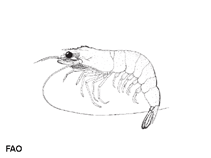Advertisement
Penaeus merguiensis De Man, 1888
Banana prawn
country information
Common names:
[No common name]
Occurrence:
Salinity:
Abundance: | Ref:
Importance: | Ref:
Aquaculture: | Ref:
Regulations: | Ref:
Uses: no uses
Comments:
National Checklist:
Country Information:
National Fisheries Authority:
Occurrences: Occurrences Point map
National Database:
Occurrence:
Salinity:
Abundance: | Ref:
Importance: | Ref:
Aquaculture: | Ref:
Regulations: | Ref:
Uses: no uses
Comments:
National Checklist:
Country Information:
National Fisheries Authority:
Occurrences: Occurrences Point map
National Database:
Common names from other countries
Classification / Names Common names | Synonyms | Catalog of Fishes (gen., sp.) | ITIS | CoL | WoRMS
Environment: milieu / climate zone / depth range / distribution range Ecology
Benthic; brackish; depth range 10 - 55 m (Ref. 8), usually ? - 20 m (Ref. 10). Tropical, preferred 28°C (Ref. 107945); 28°N - 29°S, 39°E - 168°E (Ref. 356)
Distribution Countries | FAO areas | Ecosystems | Occurrences | Introductions
Indo-West Pacific: from Kenya and the Persian Gulf to Hong Kong and Australia.
Length at first maturity / Size / Weight / Age
Maturity: Lm ?, range 3 - ? cm Max length : 24.0 cm TL male/unsexed; (Ref. 8); max. published weight: 50.00 g (Ref. 116487)
Short description Morphology
No dark brown transverse bands on the carapace and abdomen, which are uniformly glabrous. Uniformly high proximal part of triangular rostrum is particular in fully grown female. Rostrum usually armed with 7 or 8 dorsal and 5 or 6 ventral teeth. No lateral spines on telson. Color: in life, cream to yellow, sometimes minutely speckled with brown, olive green or light green pigments. Brown banded antennules; brown antennae not banded; legs and pleopds are yellowish, sometimes tinged with brown or pink; uropods with combinations of yellowish green and brownish shades. Upper margin of rostrum is fringed with brown in fully grown individuals.
Maximum depth from Ref. 10. Maximum standard length: 24.0 cm (Ref. 356). Caught mainly by trawl, gill net, fish corral, push net and filter net (Ref. 10). Juveniles are found in mangrove creek-inlets (Ref. 121464), in a mangrove vegetate area (Ref. 121475), in intertidal and subtidal edge of mud flats, near inshore and far inshore waters (Ref. 121464). Occurs in bottom mud or sandy-mud substrates in marine and estuarine environments (Ref. 8) and among shells (Ref. 121467). Inhabits shallow open sea or in the mouth of a river and bay areas where water is more or less turbid (Ref. 374). Adult species periodically form aggregations or 'schools' offshore (Ref. 100847). Omnivore (Ref. 116259).
Life cycle and mating behavior Maturity | Reproduction | Spawning | Eggs | Fecundity | Larvae
Members of the order Decapoda are mostly gonochoric. Mating behavior: Precopulatory courtship ritual is common (through olfactory and tactile cues); usually indirect sperm transfer.
Main reference
References | Coordinator | Collaborators
Holthuis, L.B. 1980. (Ref. 8)
IUCN Red List Status
(Ref. 130435: Version 2024-2)
CITES status (Ref. 108899)
Not Evaluated
CMS (Ref. 116361)
Not Evaluated
Human uses
Fisheries: commercial
FAO - Aquaculture: production; Fisheries: landings, species profile | FishSource | Sea Around Us
Tools
More information
Internet sources
BHL | BOLD Systems | CISTI | DiscoverLife | FAO(Fisheries: species profile; publication : search) | GenBank (genome, nucleotide) | GloBI | Gomexsi | Google Books | Google Scholar | Google | PubMed | Tree of Life | Wikipedia (Go, Search) | Zoological Record
Estimates based on models
Prior r = 1.18, 95% CL = 0.78 - 1.77, Based on 6 data-limited stock assessments.




